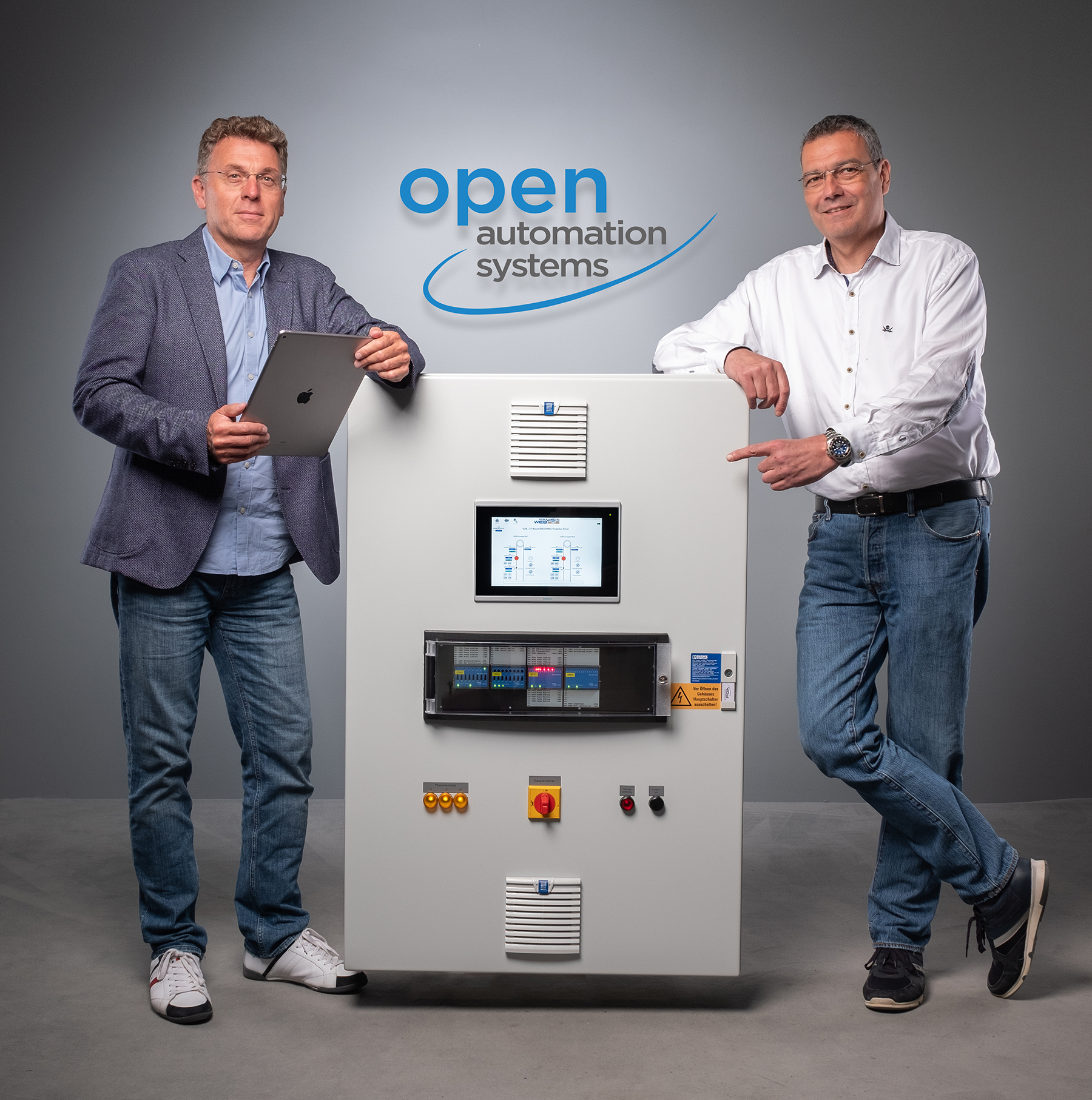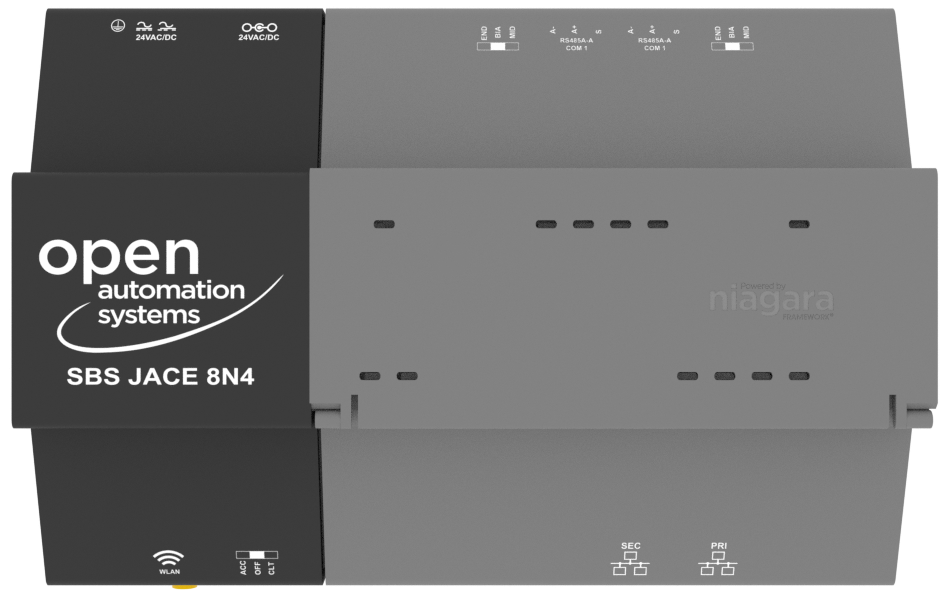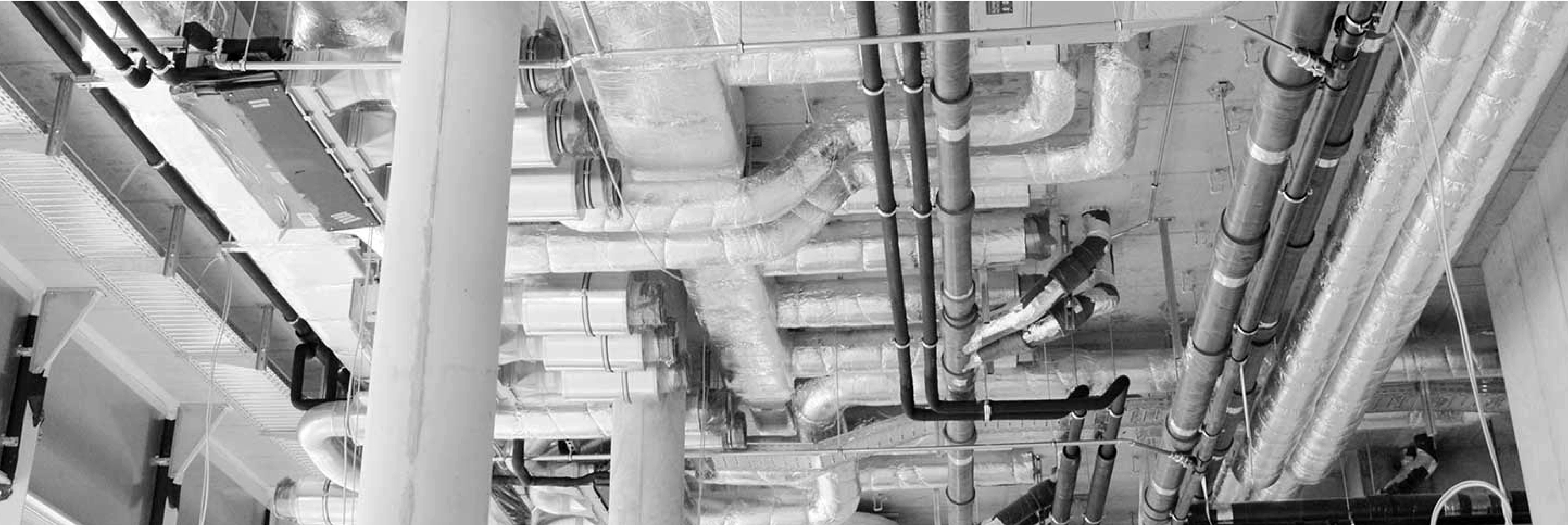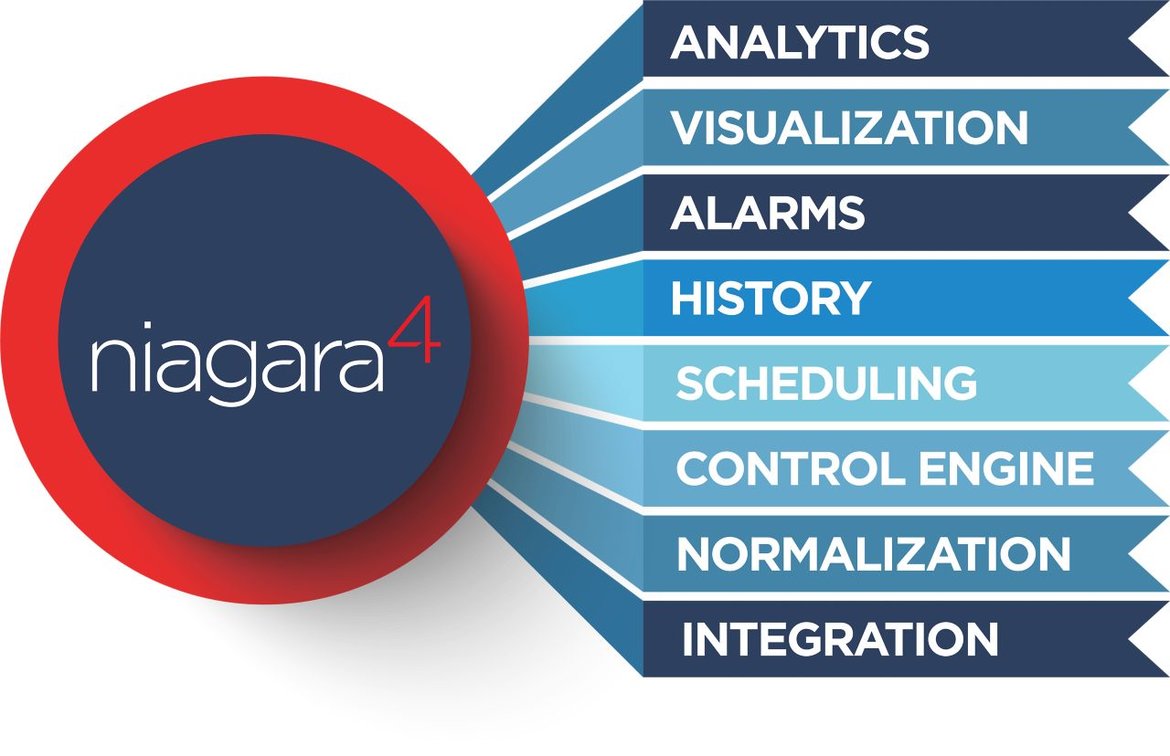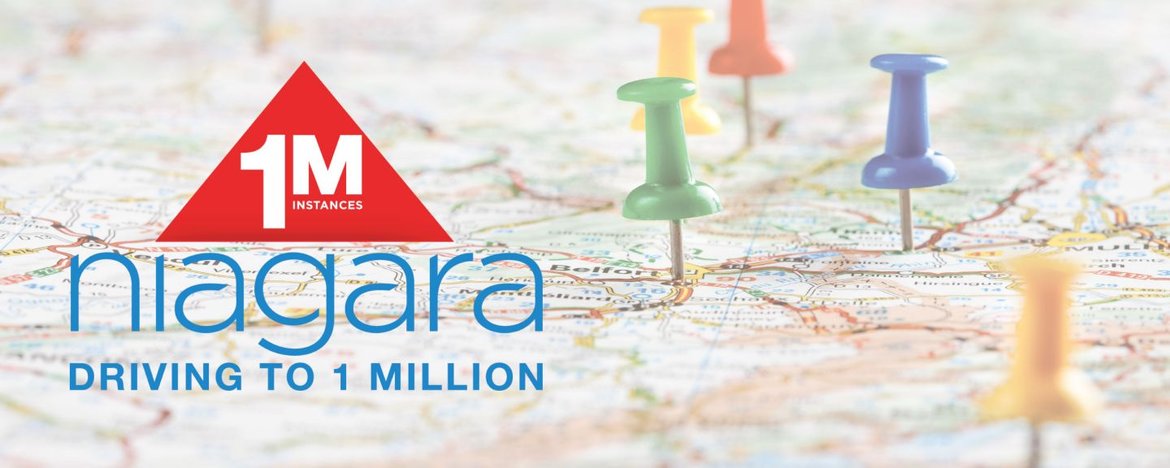Niagara Framework
Software frameworks provide a platform that enables companies to more easily create their end-product offerings. The patented Niagara framework aims to solve the challenges of managing various smart devices, unifying their data and connecting them to enterprise applications. Examples of smart devices include: Monitoring and control systems, sensors, measurement systems and embedded controls in packaged equipment systems.
Niagara 4 is a UX framework that provides an infrastructure that enables system integrators and developers to create device-to-enterprise solutions and internet-enabled control and monitoring products. The framework integrates different systems and devices (regardless of manufacturer and communication protocol) into a unified platform that can be easily managed in real time over the internet (or intranet) using an HTML5-enabled web browser of the latest version. The framework supports the use of tags that can be queried, providing the basis for many of the new features (search, tagging, relations, templates, hierarchies). The framework also includes a state-of-the-art toolset that enables non-programmers to create extensive applications in a drag-and-drop environment.
Niagara is fully scalable, which means it can run on platforms ranging from small, embedded devices to enterprise-class servers. Niagara is successfully deployed worldwide in energy services, building automation, industrial automation and M2M.
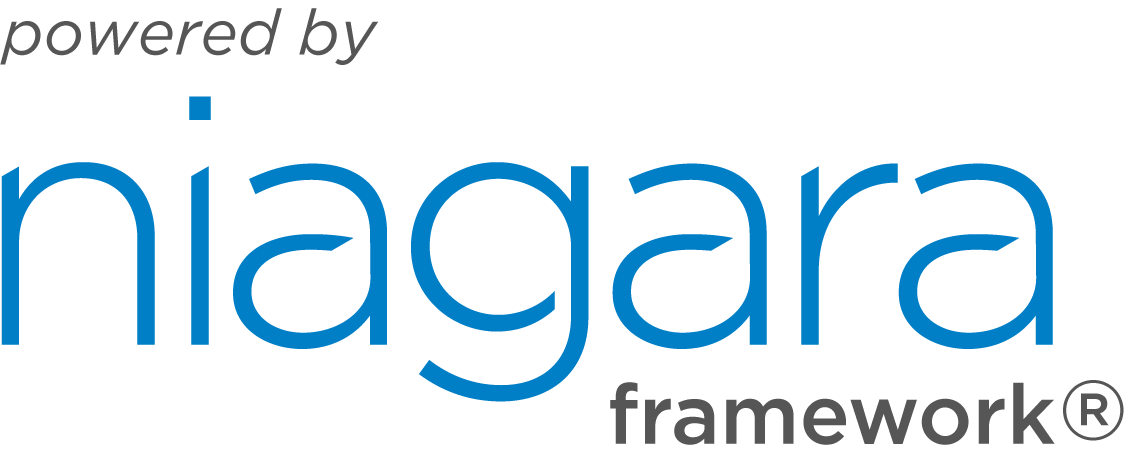
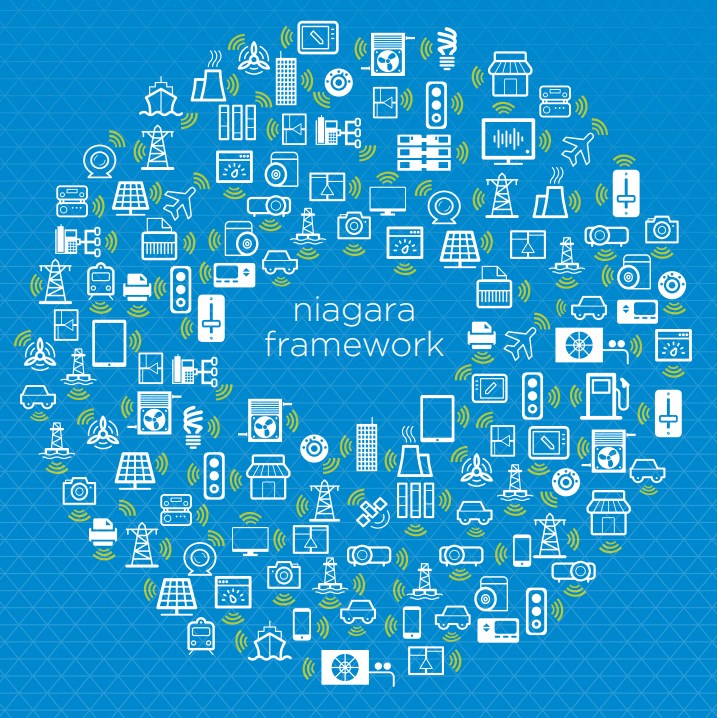
Niagara Framework Easily Connects Intelligent Systems
Niagara Framework® is a comprehensive software infrastructure that addresses the challenges of creating device-to-enterprise applications. It serves as a central console for connecting real-time operational data to the people and systems that manage workflows in smart buildings, data centers, industrial processes, smart cities and other aspects of business enterprises.
With nearly a million instances worldwide, Niagara is quickly becoming the operating system of the Internet of Things. Its open API, open distribution business model and open protocol support give you the freedom to choose how you work, what you build and with whom you partner. Niagara enables you to connect and control devices, while normalizing, visualizing and analyzing data from nearly anywhere or anything.
For almost 20 years, Tridium’s Niagara Framework has fundamentally changed the way devices and systems connect to people—and the ways people can control and optimize those machines.
From buildings and data centres to manufacturing systems and smart cities, the Niagara Framework improves strategic decision-making and enables optimised performance and cost reductions that can help organisations be more competitive and profitable. And with the release of Niagara 4 and the JACE® 8000 Controller, the opportunity to achieve operational excellence is even greater than before.

Smart Building Integration Platform
Niagara is the underlying unification platform that enables communication between a diverse host of smart, embedded devices, regardless of manufacturer or communication protocol. It models the data and behavior of the devices into normalized software components, providing a seamless, uniform view of device data to the enterprise via a wide variety of IP-based protocols, including BACnet, OPC UA, XML/SOAP, Modbus TCP, SNMP and NTP. Sharing data with enterprise applications is facilitated by the large collection of connectivity options and open APIs available through Tridium as well as from the many Independent software vendors (ISVs) and Niagara Community developers that offer connectors via the Niagara Marketplace.
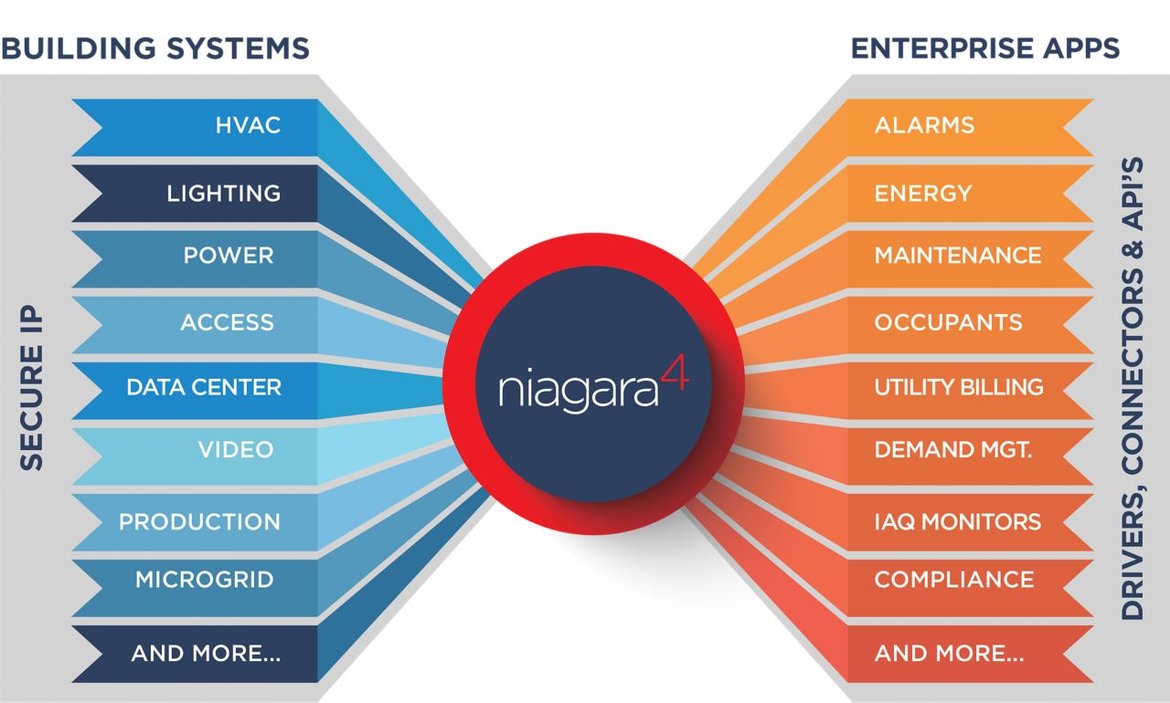
Niagara Frameworks Diverse Application
Industrial Mixed-Use
Industrial Mixed-Use
Corporate Real Estate teams that are overseeing large industrial portfolios have the combined challenge of integrating data from the manufacturing side and from corporate office space and other mixed-use facilities.
Tridium counts many Fortune-ranked industrial companies in its customer base, and the Niagara platform has evolved to unify data from sources as diverse as occupant mobile apps and assembly-line robotics. The public brands of such customers and the productivity of their employees are impacted by how they run their campuses, so facility managers are always on the lookout for smart solutions that improve operations and enhance environmental sustainability.
Airports
Airports
Airport construction projects have always been about designing the future. For more than a decade, airports like Changi Airport in Singapore, Minneapolis-Saint Paul Airport in Minnesota and many more of the world’s busiest transport hubs have deployed the Niagara Framework® to integrate the many different controls and environmental-monitoring subsystems necessary to support operations.
For example you can achieve unprecedented operational efficiency and energy savings through an on-demand control system that synchronizes operation of critical systems in the airport with flight arrivals. It’s command-control system enables the building management system, lighting control system, access control system and even the airport’s sky-train people-mover and luggage conveyors to inter-operate. The many connected devices associated with each subsystem are orchestrated based on flight data updates forwarded from the airport’s enterprise management information system to the Niagara-powered integrated controls system.
Multi-Branch Retail
Multi-Branch Retail
Retailers today rely on a wide variety of intelligent systems and devices to manage personnel, supply chain, accounting, and other enterprise management applications. Among the Tridium Niagara customers in this category is a large convenience grocery store and fueling station retailer. For this customer, Niagara Framework serves to integrate data from a variety of operational technology (OT) systems, enabling the management and control of HVAC, lighting (interior and exterior), refrigeration, food preparation, physical access security, utility meters, fuel- tank monitoring, fuel dispensing and, in some cases, car-wash irrigation. All these systems are critical to store operations and customer satisfaction. Connecting to and communicating with these devices and systems enables the store to maximize operational efficiency and profitability.
Government and Municipality Buildings
Government and Municipality Buildings
The facility and engineering teams overseeing government-owned building portfolios are faced with greater complexity and a higher imperative to demonstrate leadership when it comes to delivering comfort and energy efficiency. Portfolio-wide analytics are complex when the scope is across buildings of all ages, many brands and eras of building equipment, and scores of building service providers of all types. Niagara Framework’s open-protocol, open distribution approach also allows government customers to run competitive ‘request for proposal’ processes, allowing market forces to keep the cost of building management equipment and integration services in check. One of Tridium Niagara’s largest and longest running Niagara deployments is for a large government portfolio that now monitors over a billion data points a month.
Data Centers
Data Centers
Data center operators are a large and growing segment of the Niagara customer base. With 24X7 high availability a driving concern, they have need to proactively manage every aspect of how their facilities operate. They cannot wait for equipment failure or degradation to signal an operational problem. Investment in predictive analytics powered by Niagara achieves a multifold return when compared to the cost of downtime. Data center customers can select from numerous Niagara Community UI specialist partners to easily define custom interfaces for their facilities that are impactful, easy-to-interpret and interactive. Niagara data makes for more informed decision-making about server moves, adds and changes. Niagara can be configured for power usage effectiveness monitoring, heat and thermal mapping, power chain management, cooling optimization, reliability and uptime, co-location management and energy usage management.
Military Bases, Defense Properties
Military Bases, Defense Properties
Military installations all over the world use Tridium as a secure, compliant and flexible control system. To cite just one of many examples, when it was time for a HVAC retrofit of a depot spanning 1,295 acres and employing over 5,600 personnel, one army facilities team outfitted 21 new boilers across 10 boiler rooms with Niagara Framework controls. Military customers, with some of the planet’s most strict cyber security requirements, find that Niagara’s Defense in Depth approach helps them meet IT standards of cyber defense. Tridium builds strong cyber protections into Niagara products and works with organizations like ICS-Cert to ensure cyber best practices up and down the Niagara value chain. Niagara Community partners seeking U.S. Government site authorizations have a head start in that Niagara Framework, Niagara Edge 10 and the JACE 8000 are eligible for accreditation under the federal Risk Management Framework (RMF). Tridium has RMF artifacts they can share with these partners upon request.
Telecommunications
Telecommunications
Telecommunications network operators all over the world use Niagara-based systems to provide real time monitoring and control of remote sites and central stations. Such a Niagara deployment is at the foundation of South Africa Telekom’s network infrastructure. The SA Telekom project connected non-IP based systems including security, fire monitoring and suppression, battery backup, emergency generators, and temperature control systems into an integrated solution that is managed from a central network operations center in a fully web-based application. The system currently supports over 300 sites.
Enterprise Application Architecture powered by Niagara Framework






